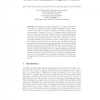Free Online Productivity Tools
i2Speak
i2Symbol
i2OCR
iTex2Img
iWeb2Print
iWeb2Shot
i2Type
iPdf2Split
iPdf2Merge
i2Bopomofo
i2Arabic
i2Style
i2Image
i2PDF
iLatex2Rtf
Sci2ools
136
Voted
IBPRIA
2005
Springer
2005
Springer
Monte Carlo Localization Using SIFT Features
The ability of finding its situation in a given environment is crucial for an autonomous agent. While navigating through a space, a mobile robot must be capable of finding its location in a map of the environment (i.e. its pose < x, y, θ >), otherwise, the robot will not be able to complete its task. This problem becomes specially challenging if the robot does not possess any external measure of its global position. Typically, dead-reckoning systems do fail in the estimation of robot’s pose when working for long periods of time. In this paper we present a localization method based on the Monte Carlo algorithm. During the last decade this method has been extensively tested in the field of mobile Robotics, proving to be both robust and efficient. On the other hand, our approach takes advantage from the use of a vision sensor. In particular, we have chosen to use SIFT features as visual landmarks finding them suitable for the global localization of a mobile robot. We have suc...
Related Content
| Added | 27 Jun 2010 |
| Updated | 27 Jun 2010 |
| Type | Conference |
| Year | 2005 |
| Where | IBPRIA |
| Authors | Arturo Gil, Óscar Reinoso, Maria Asunción Vicente, César Fernández Peris, Luis Payá |
Comments (0)

